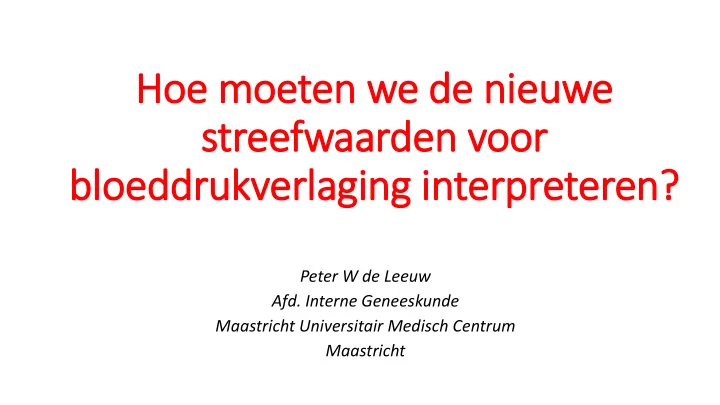

Hoe moeten we de nieuwe streefwaarden voor bloeddrukverlaging interpreteren? Peter W de Leeuw Afd. Interne Geneeskunde Maastricht Universitair Medisch Centrum Maastricht
How to to in interpret treatment targets? • Option 1: take it literally (or the fundamentalistic approach) ➢ Do what the Bible/guideline tells you to do; no thinking required
Case • Female patient, 72 years, apparently healthy • During a routine visit to her GP, the nurse practitioner measures the blood pressure and finds hypertension: 180/92 mmHg • No complaints, no other risk factors, no medication
2018 ESC/ESH Guid idelines for the Management of f Art rterial Hypertension: : BP Levels Williams et al. Eur Heart J 2018;39:3021-3104
2018 ESC/ESH Guidelines for th the Management of f Art rterial Hypertension: : Threshold for Treatment Williams et al. Eur Heart J 2018;39:3021-3104
2018 ESC/ESH Guid idelines for the Management of f Art rterial Hypertension: : Targets for Treatment Williams et al. Eur Heart J 2018;39:3021-3104
Case • Female patient, 72 years, apparently healthy • During a routine visit to her GP, the nurse practitioner measures the blood pressure and finds hypertension: 180/92 mmHg • No complaints, no other risk factors, no medication • Treatment with hydrochlorothiazide 25 mg daily; blood pressure falls to 132/74 mmHg, i.e. a decrease by 48/18 mmHg • Nurse practitioner strongly advises patient to continue the medication • Two weeks later: severe head trauma after fall (had light-headedness)
Orthostatic intolerance in the elderly • Prevalence varies from 8% (HYVET) to 30% (unselected populations) • May be as high as 60% in hospitalized/institutionalized patients • Greater prevalence during beta-blocker or HCT treatment. Volume depletion is a risk factor! • Risk of falls, ischemic episodes etc.
Williams et al. Eur Heart J 2018;39:3021-3104
Orthostatic BP fall in in SPRINT (baseline) Orthostatic falls associated with - age - female sex use of - beta-blockers, - calcium channel blockers and - combined alpha-beta blockers Townsend et al. JASH 2016; 10:847-856
Lesson 1 • Beware of orthostatic hypotension • Strict adherence to the guidelines may cause (sometimes serious) problems
How to to in interpret treatment targets? • Option 1: take it literally (or the fundamentalistic approach) ➢ Do what the Bible/guideline tells you to do; no thinking required • Option 2: handle with care (or the philosophical approach) ➢ Use judiciously as adjunct
Is Is hypertension a a qualitative or r a a quantitative trait? The old Platt-Pickering debate (1940-1960): • Platt: hypertension is an inherited tendency to develop high blood pressure in middle life; bimodal BP distribution (NT and HT) • Pickering: hypertension is a quantitative deviation from the norm: unimodal distribution of blood pressure
Consequences of f the debate • If Platt was right: treat only those with the ‘ disease ’ • If Pickering was right: ‘ treat ’ the risk, thus all people above a certain threshold
Unimodal dis istribution of f blo lood pressure in in the population Systolic and diastolic blood pressure in the Framingham population Arch Intern Med 1999;159:2206
What is is stil ill normal?
Paul-Michel Foucault (1926-1984) 1984)
Paul-Michel Foucault (1926-1984) 1984) • Surveiller et punir • Naissance de la clinique • Naissance de la biopolitique • Modern (medical) science and statistics are a way to exert power and to regulate biological and social life
Dif ifferences between Guid idelines for the Management of f Art rterial Hypertension: BP Levels
Attributable ris isk Attributable risk A shift in the distribution towards the left will lower the number of attibutable deaths
Attributable ris isk: treatment or prevention?
Changing li limits of normality
ACCORD study: in intensive vs vs le less Mean Systolic Blood-Pressure Levels at Each Study Visit in intensive BP control in in DM The ACCORD Study Group. N Engl J Med 2010;362:1575-1585
ACCORD study: in intensive vs vs le less Kaplan-Meier Analyses of Selected Outcomes in intensive BP control in in DM The ACCORD Study Group. N Engl J Med 2010;362:1575-1585
SPRINT: in intensive vs vs standard Rx Rx Rueda-Ochoa et al J Hypertens 2018; 36: epub
SPRINT: SAEs Rueda-Ochoa et al J Hypertens 2018; 36: epub
SPRINT: Effect of in intensive Rx Rx • Initially decrease of risk but this effect loses its significance after 3.4 years of follow-up • Less sustained benefit in women, blacks, patients younger than 75 years, and in those with baseline SBP above132 mmHg, those with prevalent CKD, CVD, and those who suffered SAEs Rueda-Ochoa et al J Hypertens 2018; 36: epub
SPRINT: a low DBP offsets benefit of f low SBP Minimum Baseline Sample Size Hazard Ratio of 95% Confidence Diastolic (mm Hg) Treatment-Induced Interval Diastolic Hypotension 55 9012 1.53 1.21-1.95 65 8046 1.67 1.24-2.26 70 7046 1.75 1.24-2.48 75 5639 1.89 1.23-2.90 Lee et al. Am J Med 2018; 80 4159 2.22 1.30-3.79 131:1228-1233.e1
Appli licatio ion of f SPRIN INT and and ACCORD-BP BP to to the popula latio ion (N (NHANES) Lowering the threshold for the definition of blood pressure: • will substantially increase the prevalence of hypertension and • the number of adults who qualify for antihypertensive treatment Yet: • these individuals have a markedly lower cardiovascular risk Lamprea-Montealegre et al. Hypertension; 2018:72:602-609
Relationship between blo lood pressure and th the occurrence of f vascular events and all ll-cause mortality. Dorresteijn J A et al. Hypertension 2012;59:14-21
Treatment Adherence in Men and Women Sex differences in adherence to antihypertensive treatment in patients aged above 55: The French League Against Hypertension Survey (FLAHS) Lefort et al. J Clin Hypertens 2018; DOI: 10.1111/jch.13387
Lesson 2 • Foucault-ism drives our targets to lower levels • Benefits become progressively less when we lower the targets • Lower targets require more medication, leading to less adherence
Overall conclusion • The current tendency to set lower levels for the definition of hypertension and the threshold for treatment may, in the long run, do more harm than good • The new guidelines regarding treatment targets should be applied with great caution
Recommend
More recommend